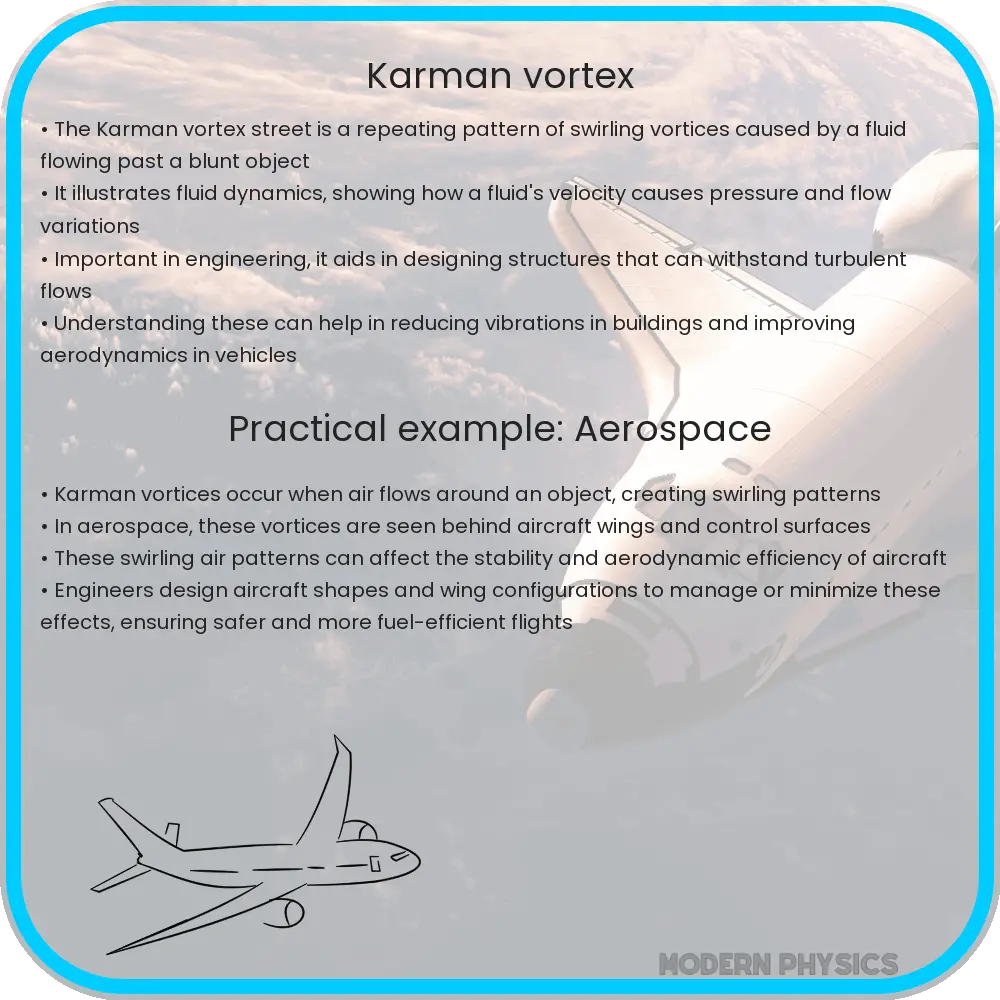Explore the intriguing Kármán Vortex Streets in fluid dynamics, their formation, stability, and impact on engineering and environmental studies.

Kármán Vortex Street: Understanding Fluid Dynamics and Patterns
The Kármán Vortex Street, named after the esteemed aerodynamicist Theodore von Kármán, is a phenomenon in fluid dynamics that exhibits a repeating pattern of swirling vortices. This intriguing pattern occurs when a fluid flows around a blunt body, such as a cylinder or a sphere. The study of Kármán Vortex Streets is not just academically fascinating but also holds significant practical applications in engineering, meteorology, and environmental science.
Formation and Characteristics
The formation of a Kármán Vortex Street occurs under certain fluid flow conditions, primarily determined by the Reynolds number (Re). The Reynolds number is a dimensionless quantity in fluid mechanics used to predict flow patterns in different fluid flow situations. It is defined as Re = ρvL/μ, where ρ is the fluid density, v is the fluid velocity, L is a characteristic linear dimension (like the diameter of the cylinder), and μ is the dynamic viscosity of the fluid.
For a Kármán Vortex Street to form, the Reynolds number must be in a specific range, typically between 40 and 1000 for flow past a cylinder. Below this range, the flow remains laminar and symmetrical. As the Reynolds number increases, the flow becomes unstable at some point, leading to the periodic shedding of vortices on alternating sides of the object. This shedding of vortices is what creates the distinct “street” of swirling motions downstream of the object.
Stability and Patterns
The stability of the vortex street is a complex interplay of forces. The Strouhal number (St), another dimensionless parameter, plays a crucial role in this. It relates the frequency of vortex shedding (f) to the velocity of the fluid (v) and the width of the body (D), defined as St = fD/v. The Strouhal number helps in predicting the vortex shedding frequency and understanding the stability of the flow pattern.
The visual pattern of the Kármán Vortex Street is not only a beautiful demonstration of fluid dynamics but also a practical tool. Engineers use these patterns to understand flow-induced vibrations in structures, which is crucial for the design of tall buildings, bridges, and even aircraft. In nature, these vortex streets can be observed in cloud formations or in the wake of islands in high-velocity air or water flows.
Practical Implications and Applications
The practical applications of Kármán Vortex Streets are vast and varied. In engineering, understanding these vortex patterns is crucial for designing structures that can withstand flow-induced vibrations. For example, in the construction of bridges and skyscrapers, engineers must account for the potential impact of wind-induced vortex shedding to prevent oscillations that could lead to structural failure. Similarly, in the aerospace industry, the knowledge of vortex behavior aids in the design of more efficient and stable aircraft wings.
Environmental and meteorological studies also benefit from the understanding of Kármán Vortex Streets. In the study of river flows and ocean currents, these vortex patterns provide insights into the behavior of fluid flows, which is essential for environmental monitoring and predicting ecological changes. Furthermore, the phenomenon is observed in atmospheric sciences, particularly in cloud formations and weather prediction models.
Challenges and Future Directions
Despite the extensive understanding of Kármán Vortex Streets, there remain challenges and areas for further research. One of the primary challenges is accurately predicting the onset of vortex shedding in different fluid flow scenarios. This involves a deeper understanding of the transition from laminar to turbulent flow, which is influenced by various factors like fluid properties, flow velocity, and the shape of the object.
Advancements in computational fluid dynamics (CFD) and high-speed imaging technologies are paving the way for more detailed and accurate studies of vortex phenomena. Researchers continue to explore the intricate dynamics of vortex formation and shedding in various contexts, ranging from microfluidics to large-scale environmental systems. These studies not only enhance our understanding of fluid dynamics but also contribute to the development of innovative solutions in engineering and environmental management.
Conclusion
The study of Kármán Vortex Streets transcends theoretical interest and serves as a cornerstone in various practical applications. From the design of resilient architectural structures to the prediction of environmental patterns, the understanding of these vortex phenomena plays a pivotal role. As research continues to evolve with technological advancements, the insights gained from the study of Kármán Vortex Streets will undoubtedly lead to further innovations and applications in fluid dynamics and beyond. Embracing these challenges and opportunities, the exploration of fluid dynamics continues to be a fascinating and fruitful field of scientific inquiry.
